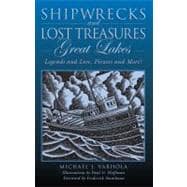
Note: Supplemental materials are not guaranteed with Rental or Used book purchases.
Purchase Benefits
What is included with this book?
| Foreword (November 10, 2006; Whitefish Point, Michigan) | |
| Written at the day and place that the wreck of the Edmund Fitzgerald is commemorated | |
| Introduction | |
| About This Book | |
| What is a Shipwreck? | |
| Treasure of the Great Lakes | |
| What passes for treasure in the Great Lakes is generally buried under hundreds of feet of water and takes the form of the cargoes carried by now-wrecked ships | |
| November Gales | |
| Great Lakes Storm of 1913 | |
| The Marysburgh Vortex | |
| This phenomenon is often described as the “Bermuda Triangle of the Great Lakes.” | |
| Modern Discoveries | |
| Technological advances like sonar and improved dive capabilities have revealed much about past shipwrecks that was once simply a mystery | |
| H.M.S.Speedy(1804) | |
| The British gunboat H.M.S | |
| Speedy sank in a blinding snowstorm in Lake Ontario with the loss of all hands, an event that changed the course of Canadian history because of the prominence of the citizens from the colony of Upper Canada lost | |
| H.M.S.Detroit(1813) | |
| Originally christened as theU.S.brig Adams, the British captured the ship, renamed it, and subsequently used it to dominate Lake Erie | |
| Americans recaptured | |
| Detroit but could not escape with it and burned it instead | |
| U.S.S.Niagara(1820) | |
| This U.S. Navy brig served during the War of 1812as Commodore | |
| Oliver Hazard Perry’s flagship during the Battle of Lake Erie, after the U.S.S. Lawrence was disabled by gunfire | |
| Unlike most Great Lakes shipwrecks, it was deliberately sunk in order to preserve it and allow it to be raised again later | |
| Lady Elgin(1860) | |
| This passenger steamer was struck by another vessel while returning hundreds of people home from a political rally | |
| It broke apart and more than 400 people perished before they could be rescued | |
| IslandQueen(1864) | |
| In one of the few Civil War military actions to spill into the Great Lakes, a party of 20 Confederatesled by Acting Master John Yates | |
| Beall captured two steamers and burned the Island Queen | |
| Alpena(1880) | |
| The sidewheel steamer Alpena was one of many ships wrecked in Lake | |
| Michigan during the “Big Blow” of October 1880 | |
| At least 80 people died when it went down | |
| Helena(1891) | |
| This oak-hulled steamer was struck by a steel vessel and sunk with a load of coal in 30 feet of water | |
| It is an interesting example of a ship that was wrecked under one name, raised, repaired, and rechristened with a new name — and subsequently wrecked again (see Amboy, below) | |
| Bannockburn(1902) | |
| For more than a century, the unexplained disappearance of this Montreal Transportation Co. freighter has been one of the classic “ghost ship” tale of the Great Lakes | |
| All that was ever found of the vessel was an oar and a single life jacket with its straps tied together | |
| Thomas Wilson(1902) | |
| One of a locally developed line of “whaleback” ships, the Thomas Wilson was struck by another ship during its approach to Duluth | |
| Both vessels were sunk as a result | |
| Amboy(1905, renamed fromHelena, sunk in 1891) | |
| After being wrecked once, this ship was raised, refurbished, and relaunched with a new name | |
| It could not escape its fate, however, and was sunk once again | |
| Mataafa(1905) | |
| After 1905, every Great Lakes captain knew the horrifying story of this vessel, which smashed into a pier and then broke in half, do | |
| Table of Contents provided by Publisher. All Rights Reserved. |
The New copy of this book will include any supplemental materials advertised. Please check the title of the book to determine if it should include any access cards, study guides, lab manuals, CDs, etc.
The Used, Rental and eBook copies of this book are not guaranteed to include any supplemental materials. Typically, only the book itself is included. This is true even if the title states it includes any access cards, study guides, lab manuals, CDs, etc.
Excerpted from Shipwrecks and Lost Treasures: Great Lakes: Legends and Lore, Pirates and More! by Michael J. Varhola
All rights reserved by the original copyright owners. Excerpts are provided for display purposes only and may not be reproduced, reprinted or distributed without the written permission of the publisher.